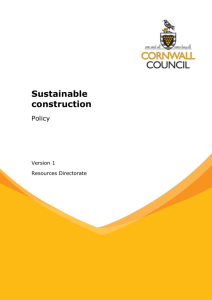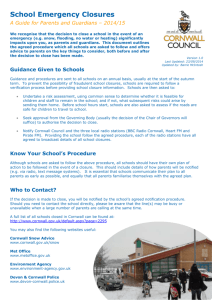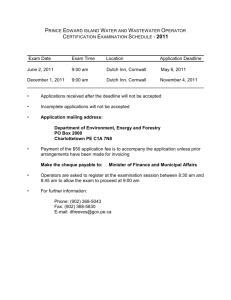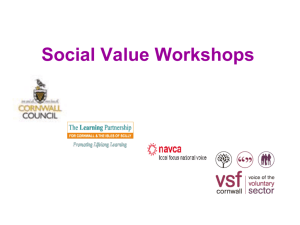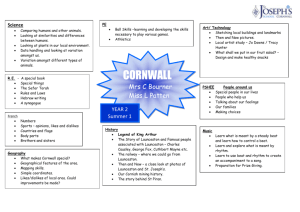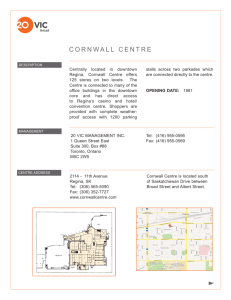Service status and picture
advertisement
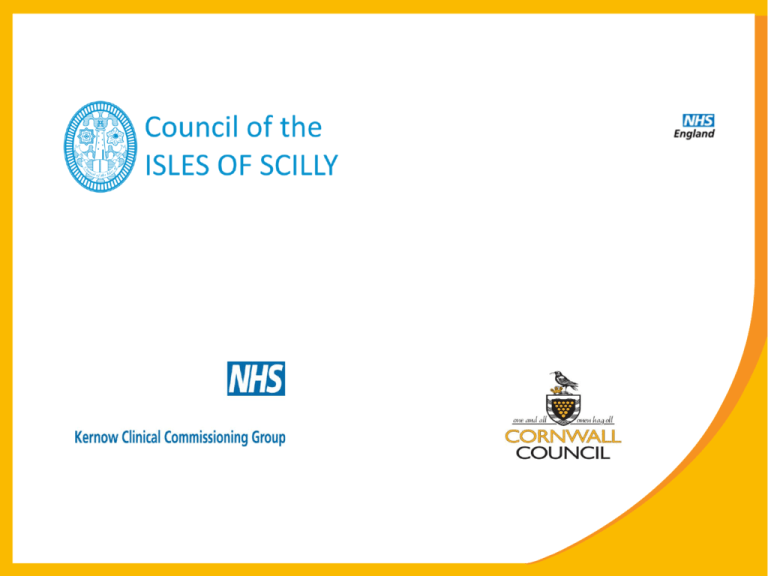
Overview and introduction Angie Andrews The future provision of Cornwall’s Children’s health and wellbeing services Potential Provider Event Content This session aims to: 1. Set the landscape for commissioning of Cornwall’s Children’s community health and wellbeing services for Cornwall Council, the Council for the Isles of Scilly and NHS England 2. Provide information about Cornwall Council’s procurement 3. Provide an opportunity for you to ask questions 4. An opportunity for your input into the specification Commissioning Partners • • • • Cornwall Council NHS England The Council for the Isles of Scilly NHS Kernow Cornwall’s Children’s Trust Vision All children, young people and their families in Cornwall are safe and have good opportunities to achieve and improve themselves. We will close the gap between those who are doing well and those who are doing less well by effective work with those with greater needs. Cornwall Children & Young People’s Plan Priorities • To provide good quality, consistent and multi-disciplinary practice in the help and protection we provide to children and young people • To develop and deliver family centered and outcome focused early help services that are responsive to need and achieve value for money through effective partnership working • To ensure healthy pregnancy from conception to birth, improving emotional wellbeing and mental health, access and quality of services to children, young people and their families, reducing hospital attendances and admissions • To enable children and young people to fulfil their academic potential and make informed choices about their futures by raising aspiration and enabling pathways into high quality opportunities in education, training and employment • To develop a confident and competent workforce across the partnership Commissioning of Cornwall’s Children’s community health and wellbeing services • In scope services: - Health Visiting School Nursing Family Nurse Partnership Specialist speech and language • Estimated approximate contract value: £10m The process • Communication, Consultation & Involvement ongoing • Project work team • Anticipated timescales contract in place by April 2016 • Outcome focussed specification based on local need • Aligning services • Tender package to be decided Cornwall remains committed to… • ensuring sustainable, high quality and accessible children’s services that are effective in addressing inequalities • securing value for money and sustainability of our children’s services • effectively targeting resources where they are most needed to improve outcomes, whilst ensuring that all families feel comfortable in accessing services • ensuring we build upon existing good quality provision and practice and address potential gaps • continue to work together in partnership Thank you for listening Senior Commissioning Manager: Angie Andrews 07968 892660 aandrews@cornwall.gov.uk Service status and picture – Health Visiting and Family Nurse Partnership Kirsty Edlin and James Bolt Service status and picture – School Nursing Brian O’Neill School Nursing Brian O’Neill School nurses The core public health offer for school-age children and young people encompasses the healthy child programme (5-19 years) including:• Health promotion and prevention by a multi-disciplinary team • Defined support for children and young people with additional and complex health needs; • Additional or targeted school nursing support as identified in the Joint Strategic Needs Assessment The healthy child programme (5-19) • The Healthy Child Programme national public health programme a robust evidence based framework good practice for prevention and early intervention services • school nursing service is pivotal in the effective delivery of evidence based support • Important for children and young people to access the expertise of school nurses and their teams The Healthy Child Programme (5-19) • Identify health issues early, so support can be provided in a timely manner; • Make sure children are prepared for and supported in education settings; • Identify and help children, young people and families with problems that might affect their chances later in life. Public Health 5-19 • Conception rate for under 18’s was 14.4 per 1000 women (211), the lowest since the 1998 baseline was set.(Q3 2013) • In 2012/13, 1.6% of all women giving birth were aged under 18 years. (higher than the regional average) • 18.1% of children in CIOS are living in poverty, which equates to 16,200 children of aged 16 and under • 8.7% of reception age children and 16.3% of Year 6 children are obese Public Health 5-19 • 25.2% of children aged 5 have one or more decayed, missing or filled teeth • A higher than national average rate for Hospital admissions as a result of selfharm (10-24 years) at 422.1 per 100,000 in 2012/13 and affected 380 10-24 year olds • Immunisation rates for HPV lower than the national average School nursing • Improve access to public health and early intervention • Reduce the prevalence of obesity in school aged children • Build capacity e.g. supporting health promoting education and other settings • Promote good mental health and wellbeing, supporting early intervention in mental ill health, and identify and help children and young people, and their families, who need support with their emotional or mental health School nursing • Improve readiness for school both at primary and secondary • Contribute to a reduction in school absences (due to ill health) and support educational attainment • Increase population immunisation and vaccination cover • Contribute to a reduction in dental decay and promote oral health • Contribute to a reduction in the number of children with continence problems School nursing • Contribute to a reduction in hospital admissions due to unintentional or deliberate injuries in under 18 year olds • Contribute to a reduction in under 18 conception rates and supporting the diagnosis of chlamydia in 15-24 year olds • Contribute to a reduction in smoking prevalence • Contribute to a reduction in alcohol and drug misuse The school age population • 88,300 children and young people age 5-19 years • 236 primary schools, 32 secondary schools • 98 Academies • 9 independent schools • 466 pupils electively home educated Service status and picture – Specialist Speech and Language Therapy Sandy Chapman Communication Support Service Specialist Speech and Language Therapy Team The team • 3.4 Specialist Speech and Language Therapists and 2.8 Speech and Language Therapy Assistants. • A therapist and assistant are based in each of the areas Mid, East and West • Staff are employed by CFT but funded by Cornwall Council • The team sit within both the paediatric Speech and Language Therapy Service (CFT) and Education, Health and Social Care (CC) What do they do? • Provide Speech and Language support to children in mainstream schools who have the most complex and severe communication difficulties • Support school staff to develop the most inclusive and appropriate learning opportunities for these children • Provide training for parents and staff in using appropriate strategies to maximise the communication potential of these children In an academic year they…. • Provide needs based support to approximately 140 children. • Provide 8 bespoke training packages based around individual children’s needs. • Provide specialist Speech and Language assessments and reports for tribunals • Provide specialist training for the community Speech and Language Therapy service • Participate in service developments for both CFT and Cornwall Council. Service status and picture – Isles of Scilly Joel Williams Service status and picture – IS Judi Morris IT & IG • • • • • Business Impact Assessment L4 Information Governance Information Security Information Sharing and Data Protection Reporting Service status and picture – Property Adam Birchall Property Context • • • • • • • Already fragmented and highly complex public sector estate – especially NHS Cornwall Council manage property assets of £1.8bn with three framework partners and single asset management function NHS family forced to manage £300m of assets split across 6 different national, local and private agencies One Public Estate Programme to address that Property strategy led by whole town approach Cannot loose efficiencies through vagaries of an individual contract Devolution of properties to Town and Parish Councils Principles • To consolidate the public sector estate – not further the fragmentation • Freedom of asset management retained by client • Managed consistently across all partners and stakeholders What does that mean at a property level? • CC freehold property occupied by current CC staff – licence to occupy on Council terms and policies, with Council freedom to lift and shift as with any other service, or provider freedom to exit if it fits overall public sector asset management programme (properties costed at fixed all inclusive rate in common with other partners) • CC property occupied by other incumbent provider – as above • CC staff in property of other incumbent provider – would seek to consolidate in to CC assets if possible; may be issues to resolve in formalising some of those arrangements in parallel with the procurement • Incumbent provider staff in incumbent provider property – uncontrolled • CC staff in private leasehold property – costs and risks to be passed directly on to new provider; but desire to consolidate where possible What does success look like? “That the new contract marries with the provision of more integrated services from fewer, better properties, with lower property revenue costs to the Council, and fully integrated with the One Public Estate programme, Devolution programme and Capital Asset Rationalisation programme” What does failure look like? “We add yet more layers of complexity to property management in the current health sector that block sensible, pro-active rationalisation and revenue savings by individual commercial interests” Feedback - What information do you need? - What level of clarity on draft leases of licences? - What property issues will cause obstacles? - Where are there other opportunities? Service status and picture – Procurement Sharon Hamilton Procurement Children’s Community Health and Well-being Services December 16th 2014 Sharon Hamilton Indicative Procurement Timetable If restricted route… • Stage 1 – Pre-Qualification Questionnaire (PQQ) – used to select providers to be invited to tender – PQQ issuance – March 2015 • Stage 2 – Invitation to Tender (ITT) – used to select providers based on future service delivery standards and price and quality – issue May 2015 If open route… • ITT issued March/April 2015 • Contract award – October 2015 • Contract Commencement – 1 April 2016 Top Tips for Tendering • Register on tendersincornwall.co.uk and Contracts Finder • Only bid for work that you are sure you can do • Make sure you accurately answer all questions • Comply precisely with the instructions • Concentrate on what the buyer is looking for, rather than your standard offer • Don’t send “glossy” brochures which have not been requested • Do not rely on reputation Top Tips for Tendering • Check your word count where relevant. Any words over the word count stipulation with not be evaluated • Review your policies on a regular basis to ensure they comply with legislation and Council requirements. All policies must have a date showing when they were last reviewed • Make sure your documents are up to date and readily available electronically • If something is not clear, ask a clarification question Top Tips for Tendering • Understand the timetable and plan your bid accordingly • Don’t miss the deadline for receipt of tenders • Provide clear and concise contact details • Thoroughly check your prices and all supporting data before submitting • Ensure you have e-mail confirmation that your application has been received • Request tender feedback, even if you are successful, as a means of improving future tender prospects Reasons why providers can fail to submit a successful bid • Failure to read all documentation and to provide the required information or to follow instructions i.e. missing a deadline. • Failure to answer the question asked. Answers provided must relate to the question asked and the service you are bidding for. • Attaching policies as answers where policies have not been requested • Not understanding that bids will only be evaluated on the information given in the answer; regardless of whether you are already doing business with the Council. Your procedures seem long and complicated… • We are bound by rules and regulations in terms of how we conduct procurement, most significantly the EU Procurement Directives • We need to manage our risks. Many of the services which we procure are high risk and we therefore have high expectations of our suppliers • We are spending public sector funds and therefore have to ensure that we get the best possible value for money and service outcomes for children, young people and their families and maintain continuity of service delivery Cornwall Supplier Development Programme • Aims at supporting potential providers through the Cornwall Council tender process • A number of resources are available at: www.cornwall.gov.uk/supplierdevelopment • One key resource is a series of public procurement webinars. These are: 45-60 mins each in length Free to access Have no software requirements • Webinars cover three main topics: Introduction to public procurement Completing a Pre-Qualification Questionnaire Submitting an Invitation to Tender Children’s Community Health and Wellbeing Services Soft Market Test Deadline: 5th January 2015 Your organisation name and background. Your understanding of what these services could offer to children in Cornwall and how outcomes for children could be improved. Explain how your organisation would ensure effective referral pathways to other Children’s Community Health and Well-being services in Cornwall, particularly in regard to the NHS Kernow Children’s Community Health and Well-being services. What factors are likely to influence your organisation’s interest in any future procurement exercise? Please identify any issues, concerns or risks that might prevent your organisation from participating in any future procurement exercise to provide these services. How would your organisation expect to bid for this work? For example on your own/consortium/other. What benefits/risks are associated with this model? Do you consider that there are any innovative options available for the delivery of these services? Any further questions ? Cornwall Council County Hall Truro TR1 3AY Tel: 0300 1234 100 www.cornwall.gov.uk
